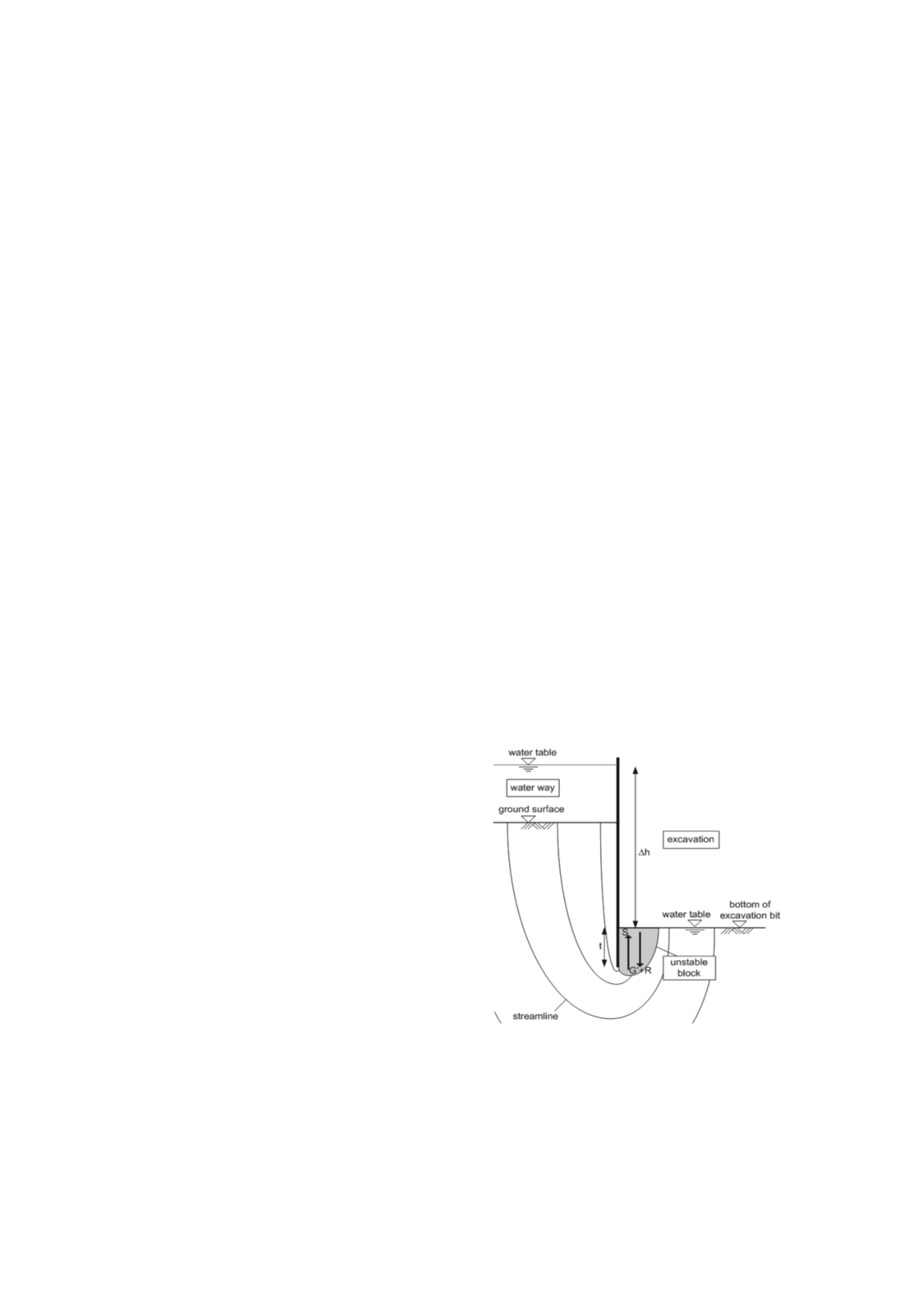
415
Proceedings of the 18
th
International Conference on Soil Mechanics and Geotechnical Engineering, Paris 2013
Experimental Analysis on the Influence of Surcharge Filters on Safety Against Hydraulic Heave
Analyse expérimentale de l'influence d'un filtre de surcharge sur la stabilité contre des
soulèvements d'eau d'une fouille de construction
Schober P., Boley C.
Institut für Bodenmechanik und Grundbau, Universität der Bundeswehr München
ABSTRACT: When designing a deep excavation pit, verifying hydraulic heave safety is in many cases crucial for determining the
necessary embedment depth of the pit wall. To reduce the required embedment depth, a surcharge filter can be installed on the pit
bottom. However, theoretical analyses show that the conventional approaches are not adequate for verifying hydraulic heave safety if
the embedment depth of the wall is low and a surcharge filter is installed on the pit bottom. Therefore, a theoretical approach with an
extended unstable block was developed by Odenwald and Herten. For further analysis and verification of this extended theoretic
approach, big scale laboratory experiments were carried out and the critical hydraulic difference in dependence of the embedment
depth and the surcharge filter thickness was determined. In the process it became apparent that the calculated results were
qualitatively accord with the experimental results of the test series, yet far more conservative. For a better understanding of the
effectiveness of surcharge filters on hydraulic heave safety, one dimensional flow-test with variation of the filter thickness and the
relative density of the sand were carried out. This paper presents the results of the experimental series und compares them to
theoretical approaches.
RÉSUMÉ : Pour des excavations à proximité immédiate des canaux de navigation en service, la vérification de la stabilité contre des
renards est déterminante pour la longueur nécessaire de la cloison de l’excavation. En installant un filtre de surcharge au fond de
l’excavation, on peut réduire la profondeur nécessaire de la cloison. Pourtant, analyses conduites sur la base des calculs numériques
des courants de l’eau souterraine montrent que les vérifications conventionnelles ne sont pas applicables pour des excavations avec un
filtre au fond de l’excavation, parce qu’elles ne prennent pas les courants verticaux au-dessous du pied de la cloison en compte, qui,
en ce cas, sont très signifiants. C’est pour cette raison qu’une méthode fiable a été développée sur la base des calculs numériques des
courants de l’eau souterraine pour déterminer l’épaisseur nécessaire du filtre de surcharge qui prend les forces des courants en
compte. Pour vérifier cette approche et analyser le mécanisme de la défaillance, de nombreux d’essais de laboratoire ont été exécutés
et exploités moyennant de différentes méthodes.
KEYWORDS: hydraulic heave, seepage failure, embedment depth, groundwater flow, safety
1 INTRODUCTION
If the water level in an excavation pit is lowered to its base, the
difference between the groundwater level outside of the
excavation pit and the water level inside of the excavation
causes a groundwater flow from the higher to the lower level.
This leads to an upward flow from the base of the retaining wall
to the pit bottom. In this case, the hydraulic heave safety has to
be verified.
If the vertical flow force S in front of the pit wall suspends
the buoyant weight of the soil body G’ as well as other possible
stabilizing forces R (Figure 1), a hydraulic heave will result.
This can lead to a rapid flooding of the pit due to regressive
erosion around the toe of the wall and eventually to a pit
collapse.
Based on the German geotechnical code, the hydraulic
heave safety has to be verified according to Terzaghi/Peck
(Terzaghi
and
Peck
1948)
or
according
to
Baumgart/Davidenkoff (Baumgart and Davidenkoff 1970). Both
approaches simply compare the acting flow forces S with the
buoyant weight of the soil G’. Possible friction forces R are
neglected. In Terzaghi/Peck’s approach a rectangular area is
defined as unstable block. The height of the rectangular area
corresponds to the embedment depth t of the wall from the
bottom of the excavation pit to the toe of the excavation wall.
The width of the rectangular area has the half of the embedded
depth of the wall t/2. The approach according to
Baumgart/Davidenkoff uses an unstable block with negligible
width and a height corresponding to the embedment depth t of
the wall.
Figure 1. Hydraulic heave at an excavation pit
In both approaches a surcharge filter is considered as an extra
load acting at the bottom of the excavation pit and which has no
significance for the shape of the unstable block. The magnitude
of the extra load corresponds to the weight of the surcharge
filter G
F
above the unstable block. The surcharge filter only
leads to a slight decrease of the water potential.
2 MOTIVATION FOR EXPERIMENTAL ANALYSIS
Motivated by a case of damage at an excavation pit next to a
waterway, Odenwald and Herten (Odenwald und Herten 2008)
started numerical flow computations respective (?) to the


